With many options for planning your ideal northwest Italy itinerary, I’m here to offer a less conventional route.
Officially, this area comprises four regions – Aosta Valley, Liguria, Lombardy, and Piedmont – each boasting countless visit-worthy spots, so you’ll need to narrow down the bucket list.
I’m sharing my Aosta Valley road trip from Turin, which offers a thrilling combo between a historically and culturally fascinating city and a region that will steal your heart with its unspoiled natural landscapes, quintessential Alpine villages, Roman remains, and medieval castles. Let’s go!
*This post may contain affiliate links from which I earn a commission (for more info, read my disclosure). As an Amazon Associate, I earn from qualifying purchases.
*I try to keep the information on this blog as updated as possible, but I still recommend consulting the latest prices, opening hours, and other details on the official website of each site, hotel, and tour, as well as checking the updated public transport routes and timetables.
*As a partner of the Get Your Guide affiliate program, I got a 15% discount when I purchased my Torino+Piemonte Card. That said, I always share my honest opinions.

My favorite carbs in this area: I will never forget the pastries of Farmacia del Cambio in Turin and the little Italian dessert of Pasticceria Buzzi in Aosta Valley.
Northwest Italy Itinerary Summary and Map
Summary
*I’ve learned from my own road trip and adjusted it a bit to make it even better for you.
Days 1+2: Turin.
Where I stayed in Turin: I booked a lovely spacious apartment in the city center – Emozione Torino.
Turin is home to a lot of must-see palaces and museums, and entrance fees (10-18 euros each) can add up quickly, so be sure to purchase the Torino+Piemonte Card (€38/€44/€49 for a 2,3, or 5-day card) to visit them for FREE and save some money (it’s one of the few city cards that are actually worth it).
Day 3: Car rental + Palace of Venaria + Fort of Bard.
Note that a ticket to the Palace of Venaria can cost up to €20 yet it’s also free to visit with the Torino+Piemonte Card.
Day 4: Cascata del Lenteney + Skyway Monte Bianco cable car + Courmayeur + Pre-Saint-Didier.
Day 5: Cogne + Cascate di Lillaz + Valnontey (optional) + Pont d’Aël + Aymavilles.
Day 6: Aosta (city).
Day 7: Saint-Vincent + Brusson Lake + Lo Copafen + Fenis Castle.
Where I stayed in Aosta Valley: I booked a big apartment with scenic balcony views in the town of Saint Pierre (in the heart of the region near Aosta city) – Le Petit Coq.
Map
Click here to see my road trip map. Note that I had only seen the Verres Castle on the outside, yet I marked it as a stop on the last day’s driving route so you could see the alternative route I took after visiting Brusson Lake.
Tip: After accessing the map, you can also open it on your Google Maps app. Simply open your app, tap the ‘saved’ icon at the bottom, scroll down and tap the ‘maps’ icon, and choose the MyMaps map you want to see (you can do the same on your computer).
Where to Stay in Turin and Aosta Valley
Turin
The best area to stay in Turin is the historic center, especially if you’re a first-time visitor and only spending a couple of days in the city.
This is the heart of the action, where the most amazing palaces, museums, restaurants, and cafes will be right on your doorstep.
On this trip, I stayed at Emozione Torino, a spacious apartment in a quiet yet central location. Another highly-rated option is Q71 Timeless Suites.
Aosta Valley
For this road trip, I was looking for a central town from where I could drive each day to a different part of the region.
Instead of the hustle and bustle of the city of Aosta, which might seem like the obvious choice, I preferred to base myself in the nearby Saint-Pierre, which didn’t offer much to do or many dining options but had the tranquility I wanted (plus, you’re going to be outside all day).
I stayed at Le Petit Coq, an amazing spacious apartment with perfect balcony views. That said, you can look for accommodations in other towns in Aosta Valley.

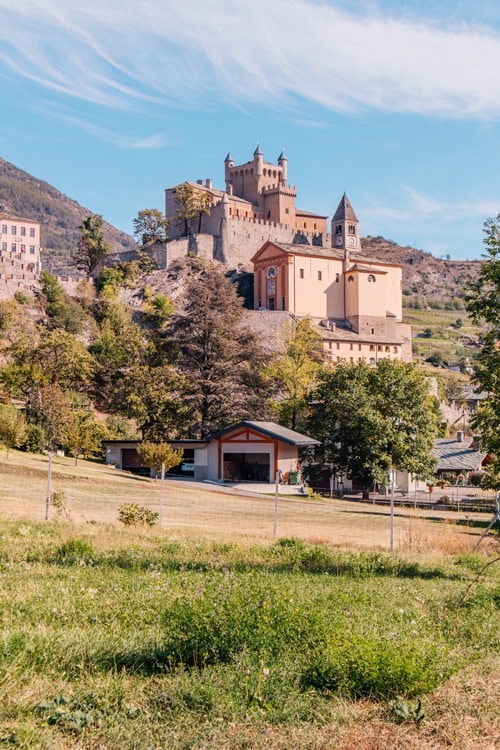
Days 1+2
Turin
As the capital of the Duchy of Savoy, the Kingdom of Sardinia, and later the unified Kingdom of Italy under the rule of the Savoy family, it served as the dynasty’s primary seat.
Consequently, both the city and the surrounding region boast numerous centuries-old royal residences, collectively recognized as a UNESCO World Heritage Site.
Turin is also celebrated as the birthplace of solid chocolate and vermouth, accompanied by the aperitivo tradition. It’s also the hometown of iconic brands like Lavazza and Fiat.
If that’s not enough, Turin will enchant you with its impressive museums (for all ages!), inviting restaurants and cafes, majestic cathedrals, striking Baroque architecture, and plenty of other attractions.

This wasn’t my first time in Turin – I got to explore it thoroughly on another trip – so in 2 days, I recommend focusing on the historic center and a couple of attractions in other neighborhoods.
My favorites include:
- Royal residences of the Savoy family: The Royal Palace (the Savoy’s main seat) and Villa della Regina.
- Museums: The Egyptian Museum (2nd-largest in the world), National Museum of Cinema (housed in the iconic Mole Antonelliana building), Lavazza Museum, and National Automobile Museum.
- Other spots: Porta Palazzo (the largest open-air market in Europe), Borgo Medievale, Piazza San Carlo, and Galleria San Federico.
Palace and museum admission fees are 10-18 euros, but if you purchase the Torino+Piemonte Card (€38/€44/€49 for a 2,3, or 5-day card), you can visit them for FREE (it’s one of the few city cards that can actually save you money).
If you need help planning your time in Turin in more detail, here are some helpful travel guides:
- Weekend in Turin
- 50+ things to do in Turin
- Is Turin worth visiting?
- Chocolate in Turin
- Cafes in Turin
- Turin travel tips
- Winter in Turin
- Hidden gems in Turin
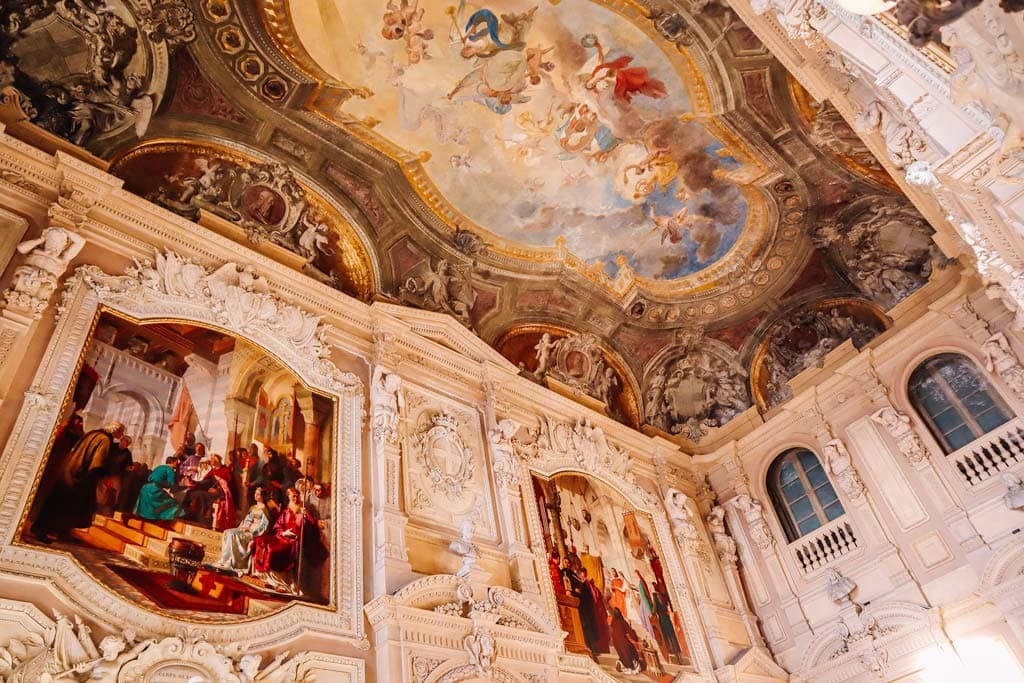
Day 3
After a couple of days in Turin, I rented a car at Sixt at the Porta Nuova train station (after comparing prices on RentalCars) and returned it at Turin’s airport at the end of the trip.
Palace of Venaria
Before exploring Aosta Valley, make another stop in the Piedmont region in one of the Savoy’s UNESCO-listed royal residences – Reggia di Venaria Reale.
Constructed in the 17th century at the behest of Duke Charles Emmanuel II, the palace originally served as a retreat for his hunting excursions in the surrounding countryside.
Over the years, it underwent various renovations and refurbishments, ultimately opening its doors to the public today.
Make sure not to overlook the breathtaking Great Gallery, the enchanting gardens framed by the majestic Alps, and the picturesque Church of Sant’Uberto, though every corner of this palace is magnificent.
Additionally, within the complex, you’ll discover a café and even a Michelin-star restaurant, adding to the allure of this historical treasure. You can also have lunch at one of the many restaurants on Via Andrea Mensa, the town’s lovely pedestrian street that leads to the palace.
I recommend reserving a timeslot in advance on the official website. I booked the “All in a Palace” ticket, which costs €20, but since the palace is free to visit with the Torino+Piemonte Card, I didn’t have to make that extra expense (when reserving your spot, mark the option that says you have purchased the card).

Fort of Bard
An easy one-hour drive (note that it includes toll roads) on the A55, E612, and E25 will get you to the Fort of Bard, our first stop in Aosta Valley.
Nestled amidst forested mountains and overlooking the Dora Baltea River, this exquisite 19th-century marvel was commissioned by the ruling House of Savoy to replace former fortifications and protect the area from French invasions.
Venturing inside, you can explore the Museum of the Alps, though it’s also possible to book a stay at the fort’s hotel – Hotel Cavour.
I was captivated by its exteriors, particularly when set against the backdrop of the surrounding landscape. You can also take a short stroll in Bard’s medieval village center.
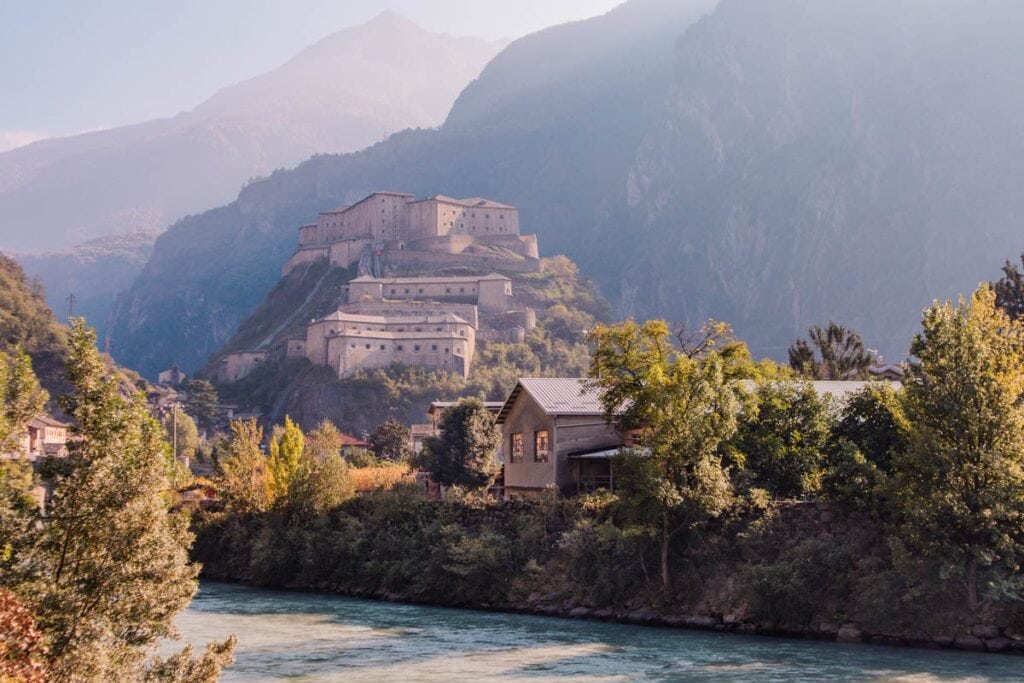
Now, you can head to your Aosta Valley accommodation.
Day 4
Cascata Del Lenteney
Heading west from Saint-Pierre (where I stayed), a relatively quick stop, yet one that will win you over, is Cascata Del Lenteney.
As you navigate along the SS26 (one of two of the region’s main roads), your eyes will be drawn to this breathtaking waterfall and the mesmerizing Dora Baltea River.
Take the opportunity to cross the quaint bridge and park your car, allowing you to immerse yourself in the scenery.
Indulge in a delightful moment at the charming Alpine-style café, La Cascata, situated perfectly on-site. Next to the cafe, you’ll see trail signs that will bring you closer to the waterfall within just a few minutes.

Skyway Monte Bianco Cable Car
One of the main attractions in Aosta Valley, yet definitely not an overrated one, is the 360-degree Skyway Monte Bianco cable car.
Both the midway station, Pavillon, and the final station, Punta Helbronner, are essential stops, offering awe-inspiring vistas of the valley and the majestic Mont Blanc massif. During the summer, you can even venture to Chamonix, France.
I recommend dedicating half a day to enjoy your visit. At Pavillon, you’ll discover a charming artificial lake, a unique Alpine botanical garden, a small exhibition tracing the cable car’s history, an infinity room (tickets are required), and much more.
Meanwhile, Punta Helbronner boasts expansive panoramic terraces overlooking Italy, Switzerland, and France (French is actually an official language in Aosta Valley and has been spoken here for many centuries).
With such breathtaking views, it’s no wonder it has become one of the happy places I love to imagine when I need some mental escapism.
I opted for the “Courmayeur – Punta Helbronner Round Trip” ticket, however, there are numerous other options available, including discounted early booking tickets, family packages, and even dining experiences. Keep in mind that you’ll need to select your ascent timeslot.
I highly recommend purchasing your tickets online (a bit cheaper than on-site), though you should consult the latest ascent schedule and rules before planning your trip.


Courmayeur
Nestled at the foot of the Mont Blanc, the Giant of the Alps, Courmayeur frequently acts as a base for soaking in the panoramic views from the Skyway Monte Bianco cable car, engaging in winter sports at the Courmayeur Mont Blanc Funivie ski resort, and exploring the scenic trails of Val Ferret and Val Veny.
Yet, the town itself holds its own charm and allure, with a quaint historic center with picturesque Alpine streets lined with hotels, shops, and restaurants (though in October, many businesses were closed).
Additionally, you can delve into the local heritage and history at its Alpine Museum.

Pre-saint-Didier
At first sight, you might not think Pré-Saint-Didier is worth the extra stop, but let me tell you why it is.
It stands out as one of two locations in the Aosta Valley blessed with natural thermal springs (the other being Saint Vincent).
These are accessible year-round at the QC Terme Pré Saint Didier wellness center or the nearby QC Terme Monte Bianco wellness center and resort (I’ll gladly go back in winter for a snowy spa vacation).
But I spent my time here relishing the views seen from the scenic Passerella Panoramica, overlooking the entire town and surrounding mountainous landscapes. It is reachable by a brief yet winding car journey, followed by a short stroll.
In this area, you’ll also find the La Thuile ski resort and numerous hiking trails.
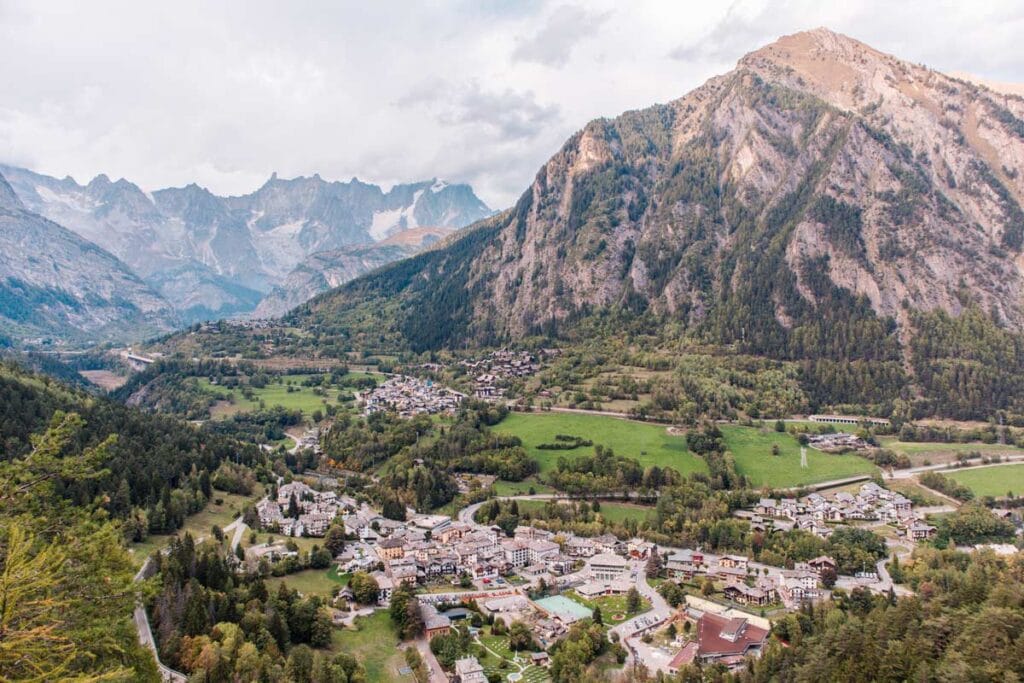
Day 5
Cogne + Cascate DI Lillaz + Valnontey
Nature is all around you in Aosta Valley, but if there’s one place you cannot miss is the infamous Gran Paradiso National Park, Italy’s oldest national park.
With countless hiking trails for all levels and other exciting outdoor activities, it’ll surely be one of your favorites on this trip.
The charming town of Cogne is nestled in the heart of the park, and it’s a perfect spot for a morning coffee (or, in my case, a second morning coffee) and a stroll.
Now, you can continue with a 10-minute drive to the parking lot in Lillaz, and follow the signs to take the short and relatively easy hike to Cascate di Lillaz. These waterfalls and the entire scenery are so stunning you’d want to spend a couple of hours here just taking it all in.
I also recommend driving from Cogne to the hamlet of Valnontey for more postcard-perfect views.
That’s just a tiny taste of the Gran Paradiso National Park, so consult the park’s official website to find more trails and activities you’ll like.
Note that if you want to see other parts of it, you’ll have to reach them via the SR23 or the SP50 (the latter is in the Piedmont region).


Pont D’aël
Aosta Valley is also known for several Roman landmarks (especially for the Roman theatre in the city of Aosta), and an intriguing one is Pont d’Aël, a Roman aqueduct and bridge built in 3 BC.
This aqueduct provides a unique experience because it has a covered passageway, which you can walk through for a small fee.
It only takes about 30 seconds to go from one end to the other, but it’s something you don’t usually get to do, so it’s still a nice addition to the itinerary.
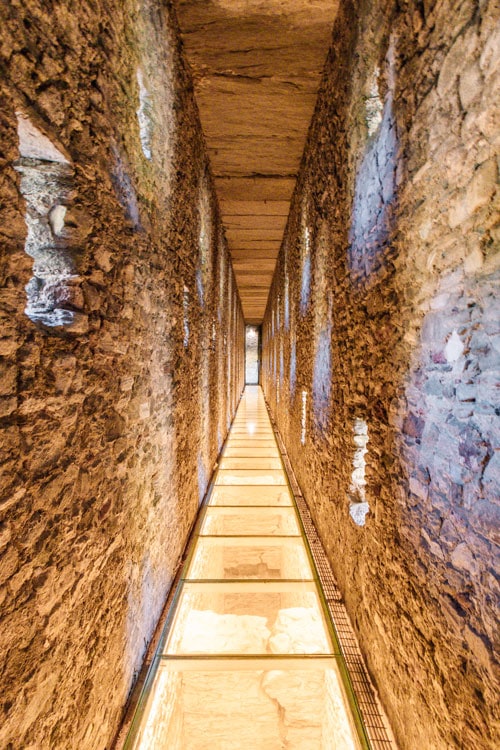
Aymavilles
I admit there isn’t much to do in Aymavilles, but it’s home to a couple of visit-worthy spots that unravel other aspects of the region’s history and culture.
The first is the 4-tower Aymavilles Castle, built in the 13th century for the noble Challant family.
There are many stunning medieval castles across the region, but most only allow a visit that includes a guided tour in Italian, so it’s a bonus that you can wander around the Aymavilles Castle on your own (you can buy tickets here).
The second is the winery and shop of Les Cretes, established in 1800. You’ll find quite a few other wineries in this area, but I loved this one’s inviting rural yet modern interiors. Other than buying their wines, you can book a tasting (as long as you have a designated driver!).
Aosta Valley might not be a famous or big wine region, but that shouldn’t stop you from enjoying it.

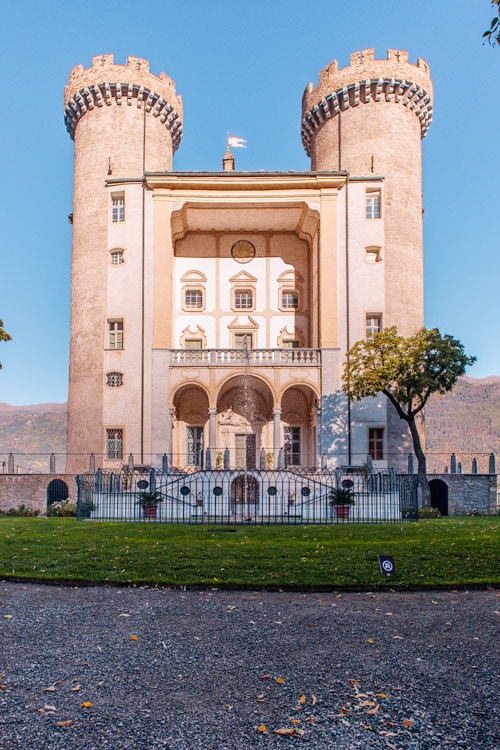
Day 6
Aosta
Thanks to its rich history as the Roman colony of Augusta Praetoria Salassorum and its meticulously preserved monuments, Aosta has earned the nickname “The Rome of the Alps.”
Visitors are drawn to iconic sites such as the Roman Theatre (currently closed until May 2025), the imposing city gate Porta Praetoria, the underground Forensic Cryptoporticus (a part of the colony’s Roman forum), and the Arch of Augustus. The medieval Aosta Cathedral and Church of Sant’Orso add to the city’s appeal.
Most of these are found in the historic center, which is a lovely area to explore. I enjoyed its quaint pedestrian streets and charming squares, all lined with a variety of shops, cafes, bars, and restaurants.
I have to say that the capital city of this region didn’t steal the spotlight during my trip, but I still see Aosta as worth visiting.
You might feel that you don’t need to spend a full day here, so add another point of interest to the agenda. I didn’t have enough time to visit it, but the village of Etroubles seems like an enchanting place to roam, situated only a short drive from Aosta.

Day 7
Saint-Vincent
This town isn’t necessarily a must-visit in Aosta Valley, but it was a nice little stop on the way to Brusson Lake.
I loved its small yet cute historic center (I had coffee and gelato at Pasticceria Gelateria Vancheri and loved it), weekly market, and imposing church – Parish church of San Vincenzo.
It’s also known for its natural thermal springs, which can be enjoyed at the Terme di Saint-Vincent wellness center throughout the year.
Brusson Lake
A scenic winding road (SR33) will get you from Saint-Vincent to this gorgeous turquoise lake surrounded by beautiful green scenery, a real hidden gem in northern Italy.
Be sure to buy some things to nibble at a bakery or a supermarket because this is a perfect picnic spot with plenty of benches and tables (and even a playground).
I spent several hours here because it was truly an incredible place. The views and the tranquility were soul-cleansing, making Brusson Lake one of my favorite stops on this road trip.
If you don’t want to drive back west on that winding road, head south on the SR45 towards the Verres Castle to get back on one of the two of the region’s main roads (SS26 and E25).

Lo Copafen
Aosta Valley is renowned for its production of fontina cheese (for over 1,000 years!), and there’s no shortage of local dishes that showcase this exquisite ingredient, such as polenta concia, fondue, and risotto alla Valdostana.
If you’re eager to sample and purchase top-quality fontina, I highly recommend a visit to the farm and shop of Lo Copafen.
This establishment has a scenic location, and the owners graciously allow you to see their cheese cellar free of charge. Their cozy shop is also lined with other amazing products, from wines to polenta to butter, so don’t leave empty-handed.
Fenis Castle
Castles and fortresses are an integral part of the region’s landscape.
One of them is the remarkable Fenis Castle, one of Italy’s most impeccably preserved medieval castles, known for its beautiful towers and fortified walls.
Dating back to the 13th century, its illustrious history is primarily associated with serving as the residence of the esteemed Challant family for over five centuries.
While I only had the opportunity to admire its picturesque exteriors, which were particularly enchanting at sunset, you can step inside by partaking in a guided tour (conducted in Italian). You’ll have access to the castle’s well-appointed rooms, famed chapel, and frescoes adorning its courtyard.

Other Tips for the Best Aosta Valley Road Trip From Turin
Car Rental and Driving Tips
- I rented the car at Turin’s Porta Nuova train station (I chose Sixt after comparing rental prices on RentalCars) and returned it at Turin’s airport (right before my flight back). You can, of course, do the opposite and visit Turin at the end of the trip.
- I know the stereotype about crazy Italian drivers, but driving in this part of the country was more than okay 99% of the time. Getting in and out of Aosta (the city) was a bit frustrating because of the traffic, so just be patient.
- On your way from Turin to Aosta, you’ll pass through a couple of toll roads, which you can pay for in cash or credit. You can save some money when traveling through Aosta Valley itself by avoiding driving on the E25 highway and choosing the SS26 instead.
- Have some spare change for parking meters.
When to Visit
Aosta Valley is a famous Italian winter destination because of its ski resorts. But other seasons can be great for hiking or enjoying the scenery without any fuss (you can see that my Aosta Valley itinerary doesn’t include any major hikes).
This time, I chose to visit northern Italy in October (at the beginning of the month) and was rewarded with perfect weather and very few tourists.
That said, some businesses were closed during that time, so sometimes it was slightly challenging to find a place to eat, and towns like Courmayeur, which I thought would be more lively, felt quite deserted (I love tranquility, but I didn’t expect to be one of the few people walking its streets).
Changing This Itinerary
There are a whole lot of ways you can adjust this Northwest Italy road trip itinerary to your liking, so here are a few ideas:
- Opt for a longer hike in the Gran Paradiso National Park.
- Dedicate a day to an area I would have loved to visit – the Gressoney Valley – home to the fairytale Castel Savoia and quaint villages that still preserve the heritage of the Walser people – a group of Germanic origin who settled here in the Middle Ages.
- Explore the Mont Avic Natural Park.
- Visit some villages and hamlets near Bard, like Pontboset, Pont-Saint-Martin, and Fontainemore.
Other Things to Know
- Many villages across the region offer a limited number of places to eat, most of which are only open for a couple of hours during lunch and dinner, so be aware to not miss meals.
- Technically, you can reach some of the places I mentioned by bus, but I highly recommend renting a car for flexibility and ease.
Other Northwestern Italy Travel Guides
Read:
- A road trip through Northern Italy’s lakes
- Best places to visit in Piedmont
- Best places to visit in Lombardy
- Northern Italy in winter
- Road trips from Milan
- Things to do in Milan on a rainy day
- Secret places in Milan
- 4 days in Milan
- Day trips from Milan in winter
- Things to do in Milan in December
- Milan or Turin
Other related posts:


*Your emil address will not be published. By using this form you agree with the storage and handling of your data by this website